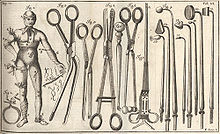Lorenz Heister
Lorenz Heister | |
|---|---|
 | |
| Born | Lorenz Heister 19 September 1683 |
| Died | 18 April 1758 (aged 74) |
Lorenz Heister (Latin: Laurentius Heister) (19 September 1683 – 18 April 1758) was a German anatomist, surgeon and botanist born in Frankfurt am Main.
Biography
From 1702 to 1706 Heister studied at the Universities of Giessen and Wetzlar, afterwards relocating to Amsterdam, where he studied anatomy under Frederik Ruysch (1638–1731). In the summer of 1707, he was an assistant physician in field hospitals at Brussels and Ghent during the War of the Spanish Succession. He then traveled to Leiden, where he studied anatomy under Bernhard Siegfried Albinus (1653–1721) and Govert Bidloo (1649–1713), also attending Hermann Boerhaave’s lectures on chemistry and ocular diseases. In 1708 he earned his doctorate from the University of Harderwijk, and in the summer of 1709, rejoined the Dutch military as a field surgeon during the Siege of Tournai. Shortly afterwards, he distinguished himself in treatment of the wounded from the Battle of Malplaquet.

In 1711 he was appointed professor of anatomy and surgery at the University of Altdorf, and from 1720, was a professor of anatomy and surgery at Helmstedt, where he remained for the rest of his life. During his tenure at Helmstedt, he also taught classes in botany and practical medicine. In 1730 he was elected a Fellow of the Royal Society.[1]
Among his numerous writings, his best-known work is Chirurgie, a book on surgery that was translated into several languages. It was used extensively in Japan, and was still employed as a standard text at Vienna as late as 1838. Heister's botanical garden in Helmstedt was considered one of the most beautiful in Germany.
In 1718, he coined the word "tracheotomy". Also, he is credited for being the first physician to perform a post-mortem section of appendicitis. His name is lent to the plant genus Heisteria, as well as to the spiral valves of Heister, defined as anatomical folds of the cystic duct. He died in Bornum am Elm.
His botanical writings were published as Beschreibung eines neuen Geschlechts in 1755, with illustrated descriptions of plants.
Principal writings
- Compendium anatomicum, initially published in 1721, 10 editions overall.
- Chirurgie, initially published in 1731, 15 editions overall.
- Institutiones chirurgicae, 1749.
- Beschreibung eines neuen Geschlechts, Braunschweig 1755 (Beschr. Neu. Geschl.)[3]
Notes
- ^ "Fellows details". Royal Society. Retrieved 18 April 2023.
- ^ International Plant Names Index. Heist.
- ^ Heister, Lorenz (1755). Beschreibung eines neuen Geschlechts von einer sehr raren und überaus schönen afrikanischen Pflanze aus der Familie der Zwiebelgewächse, welche er zu Ehren ... des ... Fürsten ... Karls ... zu Braunschweig und Lüneburg ... den Namen Brunsvigia beygelegt, wobey zugleich viele Irrthümer einiger Kräuterkenner angezeiget und verbessert werden, nebst drey ... Kupferplatten worauf obige Pflanze mit lebendigen Farben nach dem Leben dargestellet wird. Braunschweig: Waysenhause.
References
External links
![]() Media related to Lorenz Heister at Wikimedia Commons
Media related to Lorenz Heister at Wikimedia Commons
- Articles with short description
- Short description is different from Wikidata
- Articles with hCards
- Botanists with author abbreviations
- Commons category link from Wikidata
- Articles with FAST identifiers
- Articles with ISNI identifiers
- Articles with VIAF identifiers
- Articles with WorldCat Entities identifiers
- Articles with BIBSYS identifiers
- Articles with BNC identifiers
- Articles with BNE identifiers
- Articles with BNF identifiers
- Articles with BNFdata identifiers
- Articles with CANTICN identifiers
- Articles with GND identifiers
- Articles with ICCU identifiers
- Articles with J9U identifiers
- Articles with LCCN identifiers
- Articles with Libris identifiers
- Articles with NKC identifiers
- Articles with NLG identifiers
- Articles with NTA identifiers
- Articles with PLWABN identifiers
- Articles with PortugalA identifiers
- Articles with VcBA identifiers
- Articles with Botanist identifiers
- Articles with CINII identifiers
- Articles with Leopoldina identifiers
- Articles with MGP identifiers
- Articles with DTBIO identifiers
- Articles with SNAC-ID identifiers
- Articles with SUDOC identifiers
- 1683 births
- 1758 deaths
- Physicians from Frankfurt
- University of Giessen alumni
- University of Amsterdam alumni
- Leiden University alumni
- University of Harderwijk alumni
- German anatomists
- German surgeons
- 18th-century German botanists
- Academic staff of the University of Altdorf
- Academic staff of the University of Helmstedt
- Members of the Prussian Academy of Sciences
- Fellows of the Royal Society
- Scientists from Frankfurt